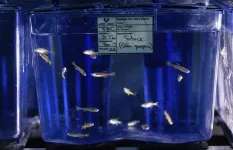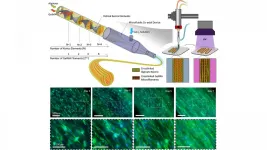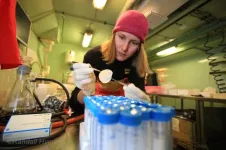(Press-News.org) Researchers at the Francis Crick Institute and UCL (University College London) have found that mice can sense extremely fast and subtle changes in the structure of odours and use this to guide their behaviour. The findings, published in Nature today (Wednesday), alter the current view on how odours are detected and processed in the mammalian brain.
Odour plumes, like the steam off a hot cup of coffee, are complex and often turbulent structures, and can convey meaningful information about an animal's surroundings, like the movements of a predator or the location of food sources. But it has previously been assumed that mammalian brains can't fully process these temporal changes in smell because they happen so rapidly, much faster than an animal can sniff.
Using behavioural experiments where mice were exposed to incredibly short bursts of odour, neural imaging, electrophysiology and computer models, the scientists found that mice can, in fact, detect very rapid fluctuations within odour plumes, at rates previously not thought possible. They also showed that mice can use this information to distinguish whether odours are coming from the same or different sources, even if they are very close to each other.
This suggests that the mammalian olfactory system, responsible for the sense of smell, is also key in processing the awareness of physical space and surroundings, guiding decisions important to survival.
Andreas Schaefer, senior author and group leader of the Sensory Circuits and Neurotechnology Laboratory at the Crick and Professor of Neuroscience at UCL says: "From an evolutionary point of view our findings make sense as they help to explain why there is a lot of computational power within the olfactory bulb, the part of the brain where the nose sends signals to. It isn't just processing chemicals from odours but can also calculate information about physical distance and source. It would have been odd for evolution to create such processing power in this part of the brain if it were not being used to help the species survive."
In one key experiment, the scientists trained mice to detect whether two odours were coming from the same source or separate sources. The mice were able to correctly distinguish this difference even when the odours were released in short blips, lasting only a 40th of a second each (40 Hz).
Tobias Ackels, postdoc in the Sensory Circuits and Neurotechnology Laboratory at the Crick says: "Previous research into the sense of smell was done on the assumption that mice couldn't distinguish the fine, fluctuating information in odour plumes.
"We've shown that mice can access and process this information - this opens up a new dimension for studying the brain; we can run experiments that more effectively trigger neurons in a natural way and challenge the olfactory bulb. This will allow us to find out more about how this part of the brain works and how information about the world is extracted by neural circuits."
As part of the study, the scientists designed new technologies including a high speed odour delivery device and equipment that can measure several odours simultaneously with extremely high precision.
These innovations will enable more sophisticated work on the olfactory bulb, increasing our knowledge of how this brain region processes information about the environment and influences behaviour. Ultimately, the team aim to build understanding of how sensory circuits link the external world with internal thought and action.
INFORMATION:
For further information, contact: press@crick.ac.uk or +44 (0)20 3796 5252
Notes to Editors
Reference: Ackels, T. et al. (2021). Fast odour dynamics are encoded in the olfactory system and guide behaviour. Nature. 10.1038/s41586-021-03514-2
The Francis Crick Institute is a biomedical discovery institute dedicated to understanding the fundamental biology underlying health and disease. Its work is helping to understand why disease develops and to translate discoveries into new ways to prevent, diagnose and treat illnesses such as cancer, heart disease, stroke, infections, and neurodegenerative diseases.
An independent organisation, its founding partners are the Medical Research Council (MRC), Cancer Research UK, Wellcome, UCL (University College London), Imperial College London and King's College London.
The Crick was formed in 2015, and in 2016 it moved into a brand new state-of-the-art building in central London which brings together 1500 scientists and support staff working collaboratively across disciplines, making it the biggest biomedical research facility under a single roof in Europe.
http://crick.ac.uk/
Chimpanzees and bonobos diverged comparatively recently in great ape evolutionary history. They split into different species about 1.7 million years ago. Some of the distinctions between chimpanzee (Pan troglodytes) and bonobo (Pan paniscus) lineages have been made clearer by a recent achievement in hominid genomics.
A new bonobo genome assembly has been constructed with a multiplatform approach and without relying on reference genomes. According to the researchers on this project, more than 98% of the genes are now completely annotated and 99% of the gaps are closed.
The ...
Graphene is a two-dimensional nanomaterial composed of carbon and formed by a single layer of densely packed carbon atoms. The high mechanical strength and significant electrical and thermal properties of graphene mean that it is highly suited to many new applications in the fields of electronics, biological, chemical and magnetic sensors, photodetectors and energy storage and generation. Due to its potential applications, graphene production is expected to increase significantly in the coming years, but given its low market uptake and the limitations in analysing its effects, little information on the concentrations of graphene nanomaterials in ecosystems ...
Loneliness and social isolation, which can have negative effects on health and longevity, are being exacerbated by the COVID-19 pandemic. More than half of surveyed adults with cancer have been experiencing loneliness in recent months, according to a study published early online in CANCER, a peer-reviewed journal of the American Cancer Society.
Studies conducted before the pandemic reported that 32 percent to 47 percent of patients with cancer are lonely. In this latest survey, which was administered in late May 2020, 53 percent of 606 patients with a cancer diagnosis were categorized as experiencing loneliness. Patients in the lonely group reported higher levels of social isolation, as well as more severe symptoms of anxiety, depression, ...
WASHINGTON, May 5, 2021 - 3D bioprinting can create engineered scaffolds that mimic natural tissue. Controlling the cellular organization within those engineered scaffolds for regenerative applications is a complex and challenging process.
Cell tissues tend to be highly ordered in terms of spatial distribution and alignment, so bioengineered cellular scaffolds for tissue engineering applications must closely resemble this orientation to be able to perform like natural tissue.
In Applied Physics Reviews, from AIP Publishing, an international research team describes its approach for directing cell orientation within ...
LAWRENCE -- Researchers at the University of Kansas have described a new species of fanged frog discovered in the Philippines that's nearly indistinguishable from a species on a neighboring island except for its unique mating call and key differences in its genome.
The KU-led team has just published its findings in the peer-reviewed journal Ichthyology & Herpetology.
"This is what we call a cryptic species because it was hiding in plain sight in front of biologists, for many, many years," said lead author Mark Herr, a doctoral student at the KU Biodiversity Institute and Natural History Museum ...
"The findings of our study tell us where and when greenhouse gas is being most absorbed in Arctic waters." Says Friederike Gründger, who conducted the study as part of her post-doctoral research at CAGE.
The study, which was conducted on the shallow shelf west of Svalbard, took a closer look at communities of bacteria that use methane as an energy source and carbon substrate for growth. The results from the study show that these methane-oxidizing bacteria are highly affected by the specific underwater landscape and seasonal conditions in the study area.
"Several large depressions, up to 40m deep, are observed along the shallow shelf off Western Svalbard, ...
In 2005, greenhouse gas (GHG) emissions from residential energy use hit an all-time high in the United States. Each year since, emissions have dropped at an average annual rate of 2 percent.
In a study published in Environmental Research Letters, "Drivers of change in US residential energy consumption and greenhouse gas emissions, 1990-2015," a team of researchers from the Yale School of the Environment (YSE) outlined several factors that have contributed to this decrease, highlighting efficiencies in new home construction, energy consumption and household appliances, ...
(Philadelphia, PA) - For patients with chronic pain, ineffective treatments, lowered work productivity, and other factors often coalesce, fueling feelings of hopelessness and anxiety and setting the stage for even bigger problems, including substance use disorders. In 2017 alone, some 18 million Americans misused prescription pain relievers over the course of the previous year. In many of these instances, patients suffering from chronic pain became addicted to prescription opioids.
In addition to being highly addictive, many studies suggest that prescription opioids do not effectively control pain over the long term, and hence researchers ...
Many people with diabetes endure multiple, painful finger pricks each day to measure their blood glucose. Now, researchers reporting in ACS Sensors have developed a device that can measure glucose in sweat with the touch of a fingertip, and then a personalized algorithm provides an accurate estimate of blood glucose levels.
According to the American Diabetes Association, more than 34 million children and adults in the U.S. have diabetes. Although self-monitoring of blood glucose is a critical part of diabetes management, the pain and inconvenience caused ...
At the beginning of the COVID-19 pandemic, intense social distancing and lockdown measures were the primary weapon in the fight against the spread of SARS-CoV-2, but they came with a monumental societal burden. New research from the Center for the Ecology of Infectious Diseases and the College of Public Health at the University of Georgia explores if there could have been a better way.
Published in the journal Proceedings of the Royal Society B, the research analyzes more palatable alternatives to the kind of social distancing mandates that threw a wrench at how businesses, schools ...






